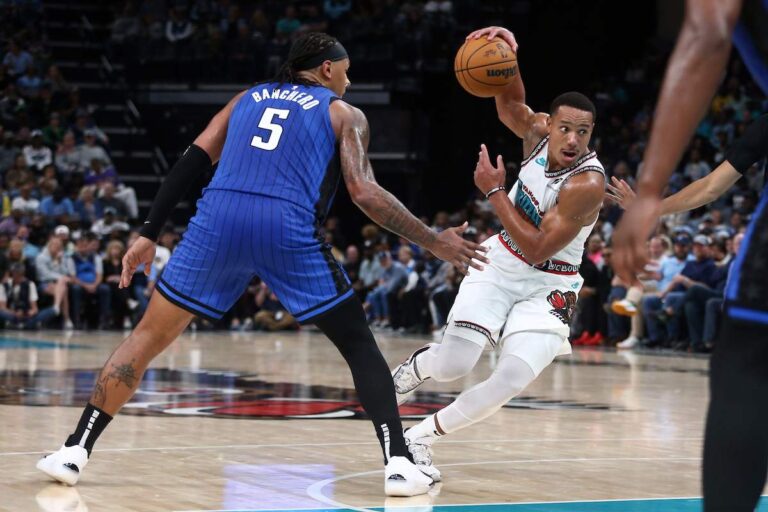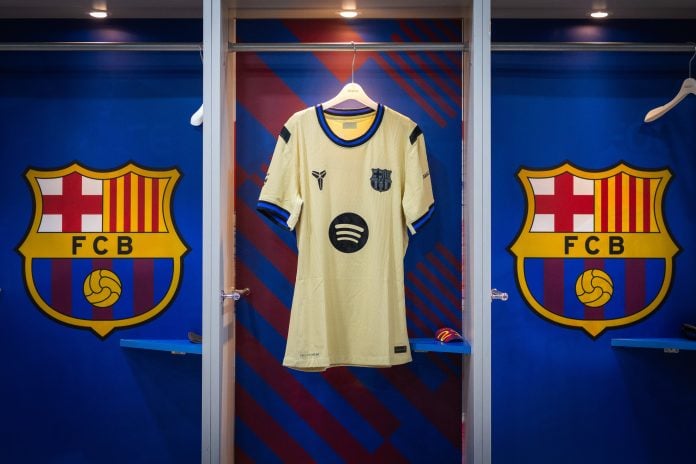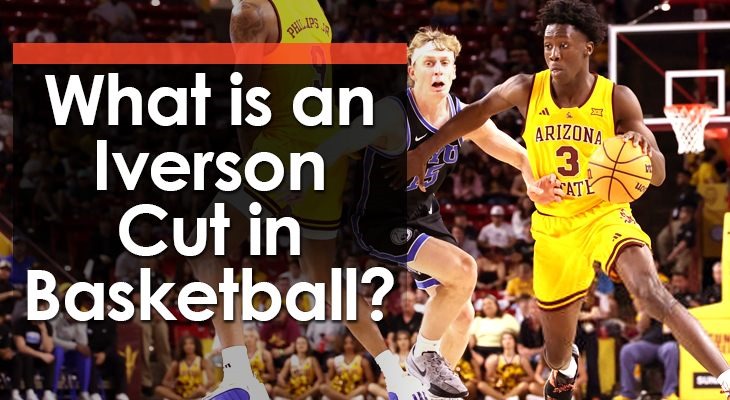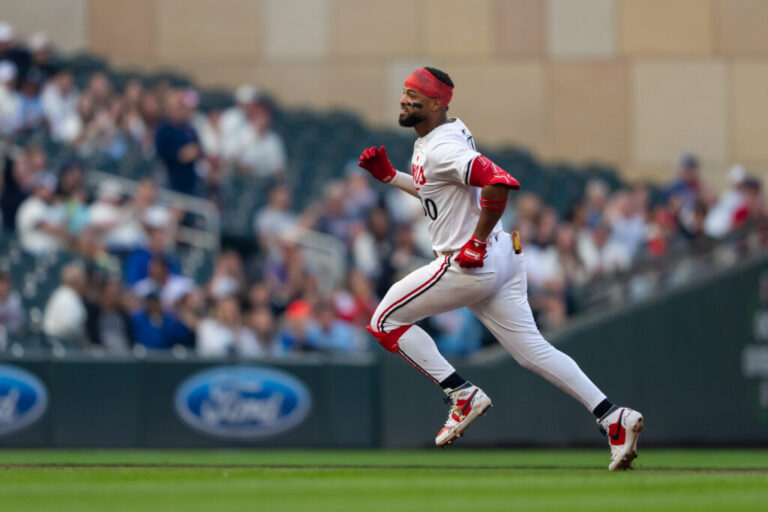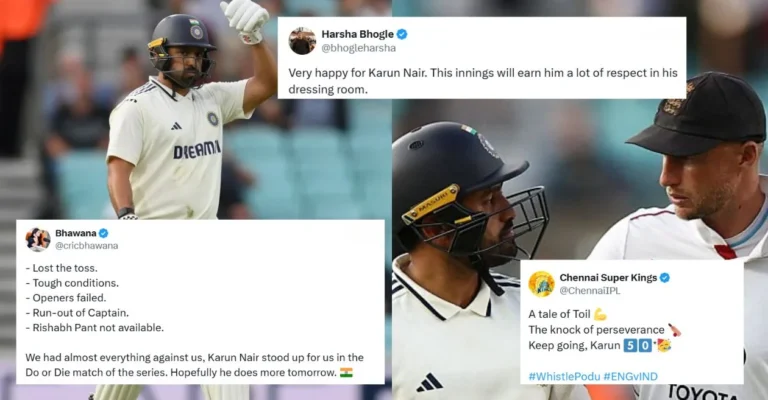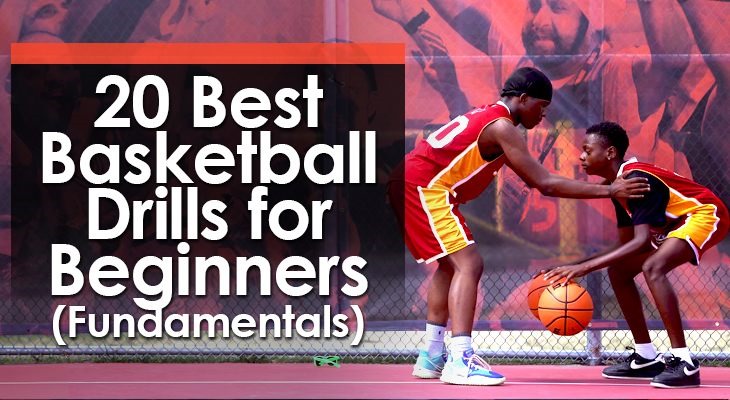


If you’re coaching youth basketball, fundamentals MUST be your primary focus.
Unfortunately, players can sometimes find these fundamental drills basic and boring…
So as a coach, you must find ways to incorporate these important fundamentals into enjoyable, fun, and competitive drills, so your players don’t even realize they’re working on the basics.
(It’s like how parents cleverly hide vegetables in meals!)
If you can do it in a game-like manner, then the benefits will be even more substantial.
Below you’ll find a list of 20 terrific basketball drills for beginners. Use these to teach new players the fundamentals of the game and improve their skills quickly.
Basketball Drills for Beginners
Shooting Drills
1. Perfects
This is a great drill to begin every practice with, as it will help your players learn what correct shooting technique looks and feels like.
Start with 3 players at each basket, each with a basketball. Put a player below each low block and the third player in the middle of the key.
The players work on the proper release of their shot and attempt to have a “perfect” shot – one that goes through the basket without hitting the rim and drops right through the net.
Each player should shoot without jumping and can use either 1 or 2 hands, depending on age and strength.
After either a certain amount of time or a certain number of perfects, the players rotate until each player has shot at all 3 spots.
This drill has players focus on their release and having proper arc on their shot so it drops right through the net without hitting anything else.


2. Spinout Shooting
This is a great drill to use when you have a lot of players in the gym and want to work on the proper footwork of a good shot.
Have each player grab a basketball and then spread throughout the gym. It’s best if each player is near or on a line so they have a target to use to see if their aim is accurate.
The drill starts with each player spinning their ball out with backspin and stepping into it to get shot ready.
All coaches have their preference for how they want players to step into a shot, but typically the 1-2 step is the most common and is easy to observe in this drill.
Players work on timing their steps, loading the ball under their chins, and getting their eyes up and focused on an imaginary rim.
The drill progresses to the players finishing with a jump shot.
The reason for each player being near a line is so they can each see if the ball is coming off their hands straight and landing on the line.
This drill is a great way to work on some of the lesser-emphasized concepts of becoming shot-ready, like footwork and loading the ball.
3. BDT Shooting
This shooting drill adds a layer of decision-making so that it’s more game-like.
This is a partner shooting drill. Each pair needs one ball. One player is the passer and the other the shooter.
Each time the passer throws the ball to the shooter, he gives a hand signal so the shooter knows how to respond.
The passer can either show target hands to signify wanting a pass back from the shooter or they can have his hands down so that the shooter takes the shot.
The passer can add in other signals as well so that the shooter reacts by driving or shooting a certain type of shot.
Players switch roles and continue the drill after a certain number of shots or makes.
This drill is much more game-like than a typical partner shooting drill as it forces the shooter to read an external stimulus to know what the proper reaction is, much like how offensive players must read the defense in a game to know how to respond correctly.
4. Good Shot, Great Shot
This is a game-like shooting drill that forces the offense to evaluate different shots and differentiate between a good shot and a great shot.
The drill begins with four spots clearly designated on the floor. Space them out so the offense is spread around the court (about 10 feet between spots), but also put them in locations where your players are able to make shots. One offensive player at each of the spots.
Then put 3 defenders in the paint. Their goal is to prevent the offense from taking an open shot.
The coach throws the ball in to one of the offensive players to begin the drill. The offensive players must either shoot or pass each time they catch the ball, but no dribbling is allowed. The defense is working to prevent any open shot attempts.
The offensive team should be able to work the ball around for an open shot relatively quickly, but you can add a shot clock to keep them looking to score.
Break your group into two teams and give each group the same number of possessions. Keep score of the number of makes after a certain number of possessions to find out who the winning team is.
The drill will help players realize the importance of ball movement and how passing up a good shot for yourself can lead to a great shot attempt by a teammate.
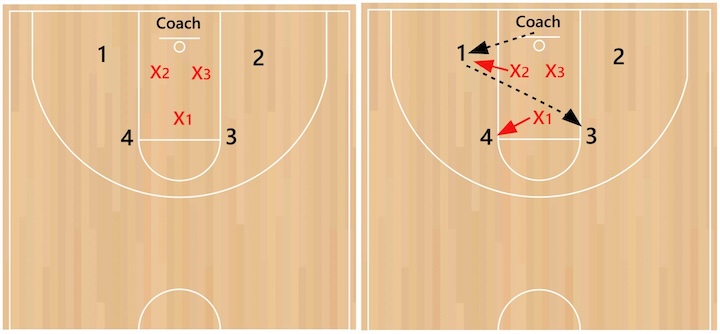

Passing Drills
5. 4 Corner Passing
This is a basic fundamental drill that works on passing and catching. But there is also a layer of focus required because of the pace and multiple basketballs involved in the drill.
There should be 4 lines of players in the drill. 2 at the low blocks and 2 at the elbows.
To begin the drill, start with one ball and have players move in a counterclockwise direction.
The player with the ball passes to the next line and follows the pass. The receiver should immediately pass the ball back to the same player, who is now much closer. The original passer will now do a touch pass back and run to the end of this line.
This player will now pass to the next line and continue this pattern and direction.
As players become comfortable with the drill, you can add one more ball at a time up to 4 total once they’re ready.
Players will be forced to communicate with passers so it’s clear who the receivers are and provide a target for them to throw to.


6. Monkey in the Middle
A simple drill, but a fun way for players to become better at faking a pass to make a pass.
Choose two players as offense and put them across from each other on the lane lines with a basketball. Have them pass the ball back and forth to each other.
Place one defender in between them who will try to deflect each pass.
The offense is not allowed to throw lob passes, and they must wait until the defensive player gets on the ball before throwing a pass.
Whenever the defender gets a deflection, that passer becomes the new defensive player.
If you have an odd number of players, you can make it more of a “Bull in the Ring” type drill, forming a circle around the defender. Keep the drill the same, just prevent the offensive players from throwing to the players right next to them.
7. Ultimate Passing
A fun passing drill, that also works on many other offensive basics like spacing, getting open, and footwork.
This drill can be played with teams of 3 – 5 players each.
The key rule for this drill is that players are not allowed to dribble or run with the ball.
After a catch, they can ONLY pivot and pass.
Any time the ball hits the floor, whether due to a drop or a deflection, it’s a turnover and the other team takes control of the ball where it hit the floor.
The goal of the drill is to reach the “end zone” by passing the ball up the floor to the opposite baseline. Once a team does this, they score a point and the other team takes possession of the ball from there.
Teams can either play for a certain amount of time or until a designated number of points.
This drill can be modified to fit specific skills a coach wants to work on, like squaring up on every catch, or the coach can set the goal to score a basket instead of getting the ball to the baseline.


8. 10 in a Row Passing
Here’s another one of the best basketball drills for beginners that works on a variety of basic fundamental basketball skills, with passing being the main one.
Make two teams of 3 – 5 players each. It’s easiest to play this as a half-court drill, and you can even put up boundaries to shrink the court if you don’t play 5-on-5.
The goal of the drill is to complete 10 passes in a row without a drop, travel, or the ball going out of bounds.
If one of those things happens, their score goes back to 0 and the other team takes possession of the ball.
Once a team reaches 10 passes in a row, they win the drill. This incentivizes the defense to play aggressively and attempt to create a turnover.
There are many potential variations of this drill that you can run to make it more challenging or focus on different skills. For instance, you can increase the number of passes that must be completed, not allow dribbling, or make it a turnover if a player doesn’t square up after a catch.
Dribbling Drills
9. Dribble Races
Dribble races are a staple of almost every youth camp around the world, but that doesn’t mean they aren’t an effective drill for improving ball-handling.
Break your group into even teams. Ideally, each group would have a maximum of 4-5 players to lessen the amount of standing around by anyone.
Give each group a basketball and clearly mark the boundaries so each player knows where to dribble to complete their portion of the race.
Before beginning, make sure the coach announces what dribble move he wants to see from everyone. Focusing on weak-hand dribbling is usually a pretty good place to start.
Depending on the age of the group, the coach can also have them do different change of direction moves, 2-ball dribbling, or even dribble backward to challenge them.
Once a member completes their portion of the race and hands the ball off to the next player in line, they can sit behind the group. The first team who has everyone complete the race and sit down is the winner.
This is a popular drill because youth players have a lot of fun competing with each other. The danger is that by competing and going as fast as they can, players lose focus on what they should be working on. So coaches must make sure to continue instructing as the drill is going on.


10. Mirror Dribbling
A different kind of ball-handling drill that forces players to dribble with their heads up to avoid running into any of their teammates.
For this drill, each player will need a basketball. Half of the players will go to one of the corners at half court and the other half will go to the baseline corner diagonal from the other group.
Before beginning, the coach will explain that once the drill begins, each player will continue dribbling for the full duration. The coach will also announce the first dribble move for everyone.
On the whistle, the first player in each line will dribble at each other toward the free throw line. As they reach that point (hopefully at close to the same time), they should both perform the dribble move and continue on to the end of the next line.
As the pair before completes the dribble move, the next person in each line will start dribbling toward the free throw line to keep the drill continuous.
After each pair does the dribble move at least once, the coach announces a different dribble move for each player to do. The drill should continue without any interruption with the new dribble move being performed.
A main focus is for each pair to complete the dribble move tightly and rub shoulders with their partner as they pass by on their way to the opposite corner.
This is another fun drill that players enjoy but also forces players to watch where they are dribbling to avoid any potential crashes with a teammate.


11. 2-Ball Dribbling
Dribbling with two basketballs is a great way to improve ball-handling. As an old college coach used to say, there’s nothing you can hide if you have a ball in each hand. This drill quickly reveals a player’s ball-handling weaknesses.
Each player will need 2 basketballs for this drill. If you are short on balls, you can have players partner up. The player without basketballs can stand in front and hold up fingers for the other player to see to force them to keep their heads up.
To begin with, focus on stationary dribbling drills for players to work on controlling the balls. Dribbling together or alternating (sometimes called popcorn) are the 2 most basic initial ones. Then you can work up to doing one thing with 1 hand and something different with the other (high-low, around the leg, etc.).
After getting good at the stationary drills, you can begin having your players move as they dribble the basketballs. Initially, it would be best to keep the distances short so that it isn’t too much for them to handle.
Again, the most common start is to begin with together and alternating dribbling. Then you can begin adding in changes of direction and having the players find ways to switch the basketballs from one hand to the other.
This drill can be a little overwhelming initially for young players. That’s why it’s important to start with the most simple parts of the drill first so they don’t get discouraged. But if they stick with it, they will see ball-handling improvement in each hand in half the time.
12. Tennis Ball Dribbling
Incorporating a tennis ball into dribbling can increase the difficulty level for players who are working on their dribbling. Plus there are numerous different ways you can use the tennis ball to add variety and keep things fresh.
The first thing you can do is give each player both a basketball and a tennis ball. Have players work on dribbling as they toss the tennis ball up in the air and catch it. This will force them to keep their heads up and focus on the tennis ball instead of staring at the basketball.
Once they get good at this initial phase, have players “Toss and Cross,” meaning toss the tennis ball up in the air as they cross the basketball over from one hand to the other. Players have to focus on making a good toss in the air so they can catch it while simultaneously completing a basic crossover dribble.
Now that they can do these things standing still, you can have them slowly move up and down the court completing each of these to make things a little more difficult.
After they have mastered those steps, you can have players partner up with their basketballs and a tennis ball. Facing each other and standing about 6-8 feet apart, the teammates can complete the “Toss and Cross” to each other instead of themselves. This drill requires total concentration so players make sure to throw good passes as they are crossing over and also catching the ball as it comes their way.
Again, adding a tennis ball to your ball-handling routine opens up many more possibilities for your players to get better. This simple added stimulus forces players to keep their focus elsewhere so that handling the ball becomes second nature.
Footwork Drills
13. Partner Pass and Pivot
This is a great warmup or skill-building drill depending on the team’s age and experience. It’s a quick, fast-paced way to teach the proper way to stop and pivot.
Players should partner up and stand on the sideline with 1 basketball per pair. The player with the basketball should be in front and ready to begin the drill.
On the coach’s whistle, the first player for each pair will begin dribbling out to the lane line area. At that point, they will execute whatever “stop” their coach prefers – a jump stop or stride stop.
After stopping, each player will do the predetermined pivot (front/back, left/right) and then pass the ball back to the partner. The partner will then take their turn dribbling out to the lane line as the original player runs back to the sideline. The coach should periodically change up the required pivot and announce it to the group.
The drill is continuous and can take place for a certain amount of time or repetitions. It’s easy to make it a competition to get players to complete the drill hard and fast.
Some key points for this drill would be making sure players don’t drag their pivot foot on the stop, that they keep the ball either low or high as they pivot toward their partners, and that their passes should be crisp and accurate.
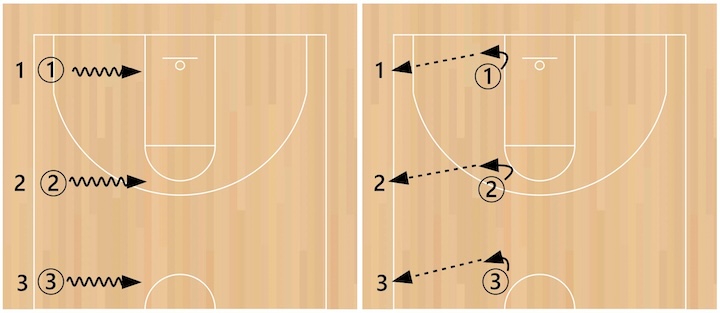

14. 4 Corner Pass and Pivot
This is a great warmup drill that allows players to work on ball-handling, passing, catching, and pivoting in a semi-chaotic environment.
Begin the drill with four lines of players. 2 in the corners and 2 on the sidelines even with the top of the 3-point line. The first player in each line will need a basketball.
On the whistle, all 4 players will dribble with their right hands toward the middle of the lane. The goal is for all 4 to get there at the same time.
Once they get to the middle of the lane, each player will stop (jump/stride) and do a forward or reverse pivot with their right foot, whichever one the coach chooses.
Players will then pass to the line they are now facing, which should be the one counterclockwise from where they began. The passers then follow their pass back to the end of the new line.
Upon catching the ball, the new players dribble to the middle of the paint to stop, pivot, and pass to keep the drill moving.
The coach should switch up the pivot foot and the direction of the pivot. Players should make sure to dribble with the same hand as their pivot foot.


15. The Red Light Game
A fun game kids love to play that also works on a variety of ball-handling and footwork skills.
Begin by having the coach explain the different verbal commands and what the players should do when they hear them:
“Green” – Players should dribble straight ahead at full speed.
“Yellow” – Players should walk forward and dribble the basketball.
“Red” – Players should stop (jump/stride) and hold the ball in triple-threat position.
“Orange” – Players should dribble the basketball as they move BACKWARD.
Next, each player should get a basketball and stand on the sideline. The goal of each player will be to complete a certain number of trips down and back to the opposite sideline, however many the coach decides.
Any time a player travels, fumbles the basketball, or does the wrong action, they must go back to the last sideline they touched.
This is a great drill for players to work on reacting to an outside stimulus to change directions or stop without turning the ball over. Plus it is fun and can be competitive if the coach decides to make the drill a race.
16. Passing Tag
A competitive drill that allows players to work on pivoting, passing, and moving without the ball.
Separate the players into two teams, Runners and Passers – just make sure the Runners outnumber the Passers.
The game will take place inside the 3-point line and can be further restricted depending on the total number of players.
On the whistle, the Runners begin moving around the playing area. The Passers move around, passing the ball to each other, trying to lightly tag the Runners. After catching the ball, Passers can only pivot, no dribbling allowed.
Once a Runner gets tagged, they are out and must wait until the next round to play again. To add to the challenge, you can allow Runners to deflect passes as well.
Play for a certain amount of time or until no Runners are left.
Passers will not have a long time to make a tag once they catch the ball, so they need to quickly pivot on the catch and stay on balance. Penalize Passers who travel by calling them out or bringing back one of the Runners.
Ensure Passers keep a “heavy” pivot foot so they aren’t moving or dragging it during the drill as they attempt to make tags. This game will help develop quick, decisive passing and proper footwork.
Finishing Drills
17. Octopus Finishing
This is a great skill development drill that works on developing ball-handling as well as finishing from a variety of different angles.
Before beginning, the coach must set up 5 cones around the perimeter: 1 at the top of the key, 1 at each wing, and 1 in each corner. The coach should set cones up at each basket that will be used during the drill.
The first player at each basket will get a basketball and stand under the rim.
On the whistle, the player will dribble around the cone in the right corner with a right-hand dribble and back to the basket for a layup.
The player will then grab the ball out of the rim and progress to the remaining 4 cones, always dribbling and finishing with the right hand.
Once the player gets done finishing from these 5 spots, they should immediately go back through each spot, this time dribbling and finishing with the left hand.
Make sure players always keep the ball away from the cones as they dribble around them and encourage them to try out different finishes to find new ways to score in the paint.
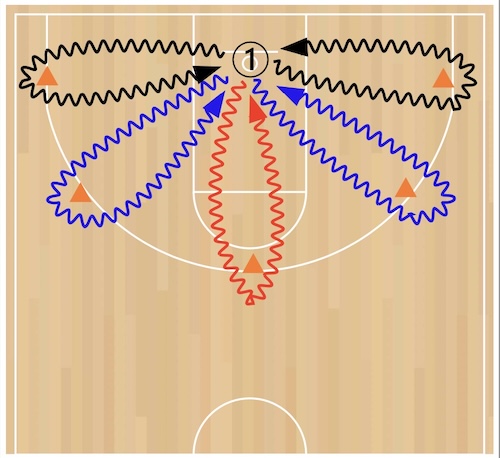

18. Chaser Layups
A full-court drill that works on layups at full speed with an approaching defender closing in.
Players will get a partner and have 1 basketball per pair. The offensive player will start with the basketball a few steps up the floor from the baseline. The defender will start on the baseline slightly inside the offensive player.
On the whistle, both players take off at the same time. The offense dribbles as fast as they can to the opposite basket for a layup, and the defender attempts to cut off the offensive player before that happens.
Once a pair finishes, they stay at the opposite baseline, switch roles, and will come back the other direction.
Coaches should make sure to work both hands, especially the weak one.
What makes this drill so effective is that it works on so many essential offensive skills:
Dribbling fast but under control, finishing while going full speed, and being able to make a layup under pressure and maybe even with contact.
Coaches can vary the position and gap between the players to create different opportunities for the players. It’s also an easy drill to make competitive by making 2 teams and keeping track of makes.


19. 1-on-1 Rip Layups
This finishing drill will give players a more realistic, game-like situation than normal layup lines that are often used.
Have players partner up and get a basketball per pair. The two should face each other at the 3-point line on the wing area, about an arms-length apart.
To begin, the defensive player will be the player on the inside. This player will be straddling the 3-point line. The defender will hold the basketball at about waist level with one hand on top and one hand on the bottom with arms extended.
The offensive player then gets positioned with both feet above the 3-point line, which puts them at a slight disadvantage. The offensive player then rips the ball from the defender’s hands and attempts to get to the rim as quickly as possible for a layup. It is live on the rip, so the defender attempts to chase and prevent the offense from scoring.
Ensure the defensive player holds the basketball tightly to force the offense to really rip the ball aggressively and get to the rim.
The added defensive player forces the offense to read what the most effective finish will be in any given situation based on the defense’s positioning. It’s also a great way to simulate contact on the way to the rim and help the offense hold their line to the basket.
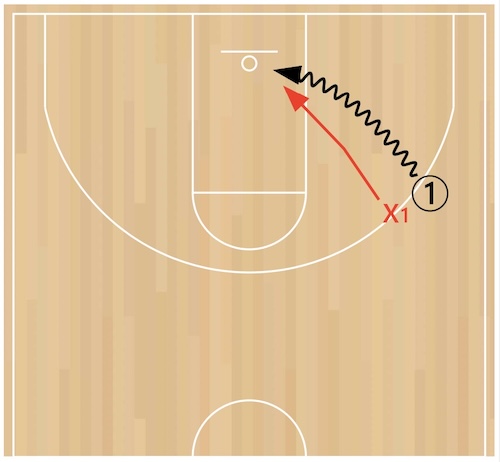

20. 1-on-1 Block Finishing
Another 1-on-1 drill that forces the offense to learn how to protect the basketball and finish in the paint against a defender.
Begin the drill by having a player with their inside foot on each block and their back to the baseline. Then have a coach with a basketball near the free throw line.
To begin the drill, the coach will throw the ball to either of the players who will then turn and finish the inside shot. On the pass, the other player will become the defender and attempt to contest the shot.
Make sure the offensive player immediately front pivots on their inside foot to get closer to the rim and also shield the ball from the defender. This will also force them to always finish with their outside hand, no matter what side of the hoop they are on.
Another version of this drill is to add a set defender in the middle of the lane and make it 2-on-1. The offensive players are both working to catch and finish or get an offensive rebound and go back up with it.
This setup puts the defender much closer to the offensive players and makes it a more contested shot and therefore more difficult.
Play until one of the offensive players scores or the defensive player grabs a rebound.


Conclusion
These basketball drills for beginners are a great way to have your team work on their fundamentals, but do it in a slightly different way than they’re used to.
Players will be building new skills while performing fun and competitive drills.
The added component of a defender in many of these drills forces a degree of decision-making, which is the most important fundamental skill for your new players to develop.
